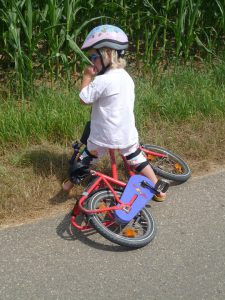
 Have you ever wondered how you would handle the situation if you are out with a friend mountain biking one day as his mountain bike crashes? What if he or she is seriously injured?
Have you ever wondered how you would handle the situation if you are out with a friend mountain biking one day as his mountain bike crashes? What if he or she is seriously injured?
This post contains affiliate links, which means that the owner of this website will be paid commissions from qualifying purchases.
First Aid Kit for Cyclists and Triathletes
Never go mountain biking without a first aid kit, like the one linked to above, as you never know when you will need it. If you want to find out more click on the link above.
This one is specially designed with cyclists in mind.
- Compact & Secure: Straps easily onto your bicycle for on-the-go first aid.
- Stay Safe on the go: Includes 50 essential first aid supplies.
- Weatherproof Protection: Waterproof casing ensures supplies stay dry in any conditions.
- Cyclist’s Safety Companion: Essential for handling minor injuries and emergencies while cycling.
- Versatile: Suitable for all cycling adventures, from leisure rides to intense trails.
This first aid kit is designed to fit on a bike. The gauze, bandages, ointments and wraps contained in this first aid kit for cyclists will help you address most of the common injuries you might incur while riding and make it possible to have first aid when and where you need it, like if your mountain bike crashes. This is an ideal accessory for long distance cyclists, triathletes, mountain bikers and in fact anyone who rides a bike.
Here are some tips for -:
Mountain Bike Crashes or Accidents
Unfortunately, broken bones and fractures are a really common phenomenon when doing mountain biking in the great outdoors. Here is what to do if your cycling buddy’s mountain bike crashes or he breaks something while you are out riding with him.
Broken Leg
If for instance, he breaks his leg, first think ABC (Airway, Breathing, and Circulation). Get your victim safe, warm, dry and arrange the injured area so that the pain is least felt.
The body will initiate a defense response after a bone is broken by making the area around the injury swell up, in an attempt to protect the area. This will be the main clue that the bone is either broken or fractured.
A broken bone may also sometimes become displaced. This means that the fragments of bone are no longer in the normal alignment. This could cause the broken fragment to kink, block or even cut the blood vessels within the limb. If there is no blood flow to the limb, the person may lose that extremity after only a short period of time.
Check your friend for a foot pulse. Compare by feeling the other leg, and if you can’t feel a pulse, then it could be one of the following:
- You could be feeling in the wrong place;
- If the person is in shock, the peripheral arteries will be clamped and hard to feel;
- If the person is cold, you will also battle to find a pulse as the arteries will be clamped.
If the extremity is blue and cold, you may need to distract or pull apart the broken ends and then splint the extremity in such a way that the artery will not become recompressed during transport to the hospital. This process will hurt like hell and should be done as quickly and efficiently as possible.
Before attempting to splint, make sure you know how to do this properly, as you could cause much pain if you are not quick and efficient.
If anyone has painkillers or muscle relaxants, make sure to administer them as soon as possible as they normally take about twenty minutes to kick in. Remember to check that your patient is not allergic to anything.
Broken Clavicle
A clavicle fracture is a break in the collarbone, which is one of the main bones in the shoulder. This type of fracture is fairly common, as most clavicle fractures occur when a fall onto the shoulder or an outstretched arm puts enough pressure on the bone that it snaps or breaks. A broken collarbone can be very painful and can make it hard to move your arm.
You will know that the clavicle is broken by the following symptoms:
- Sagging of the shoulder downward and forward.
- Inability to lift the arm – too painful.
- A deformity or “bump” over the break.
- Bruising, swelling, and/or tenderness over the collarbone.
If the clavicle is broken, this bone cannot be splinted. Rather just fold the arm at a ninety-degree angle across the chest and strap down with bandages, not too tightly.
Most clavicle fractures can be treated by wearing a sling to keep the arm and shoulder from moving while the bone heals. With some clavicle fractures, however, the pieces of bone move far out of place when the injury occurs. For these more complicated fractures, surgery may be needed to realign the collarbone.
It is always advisable to get some sort of First Aid Training before embarking on any extreme sports, as you never know when your training will come in handy.
